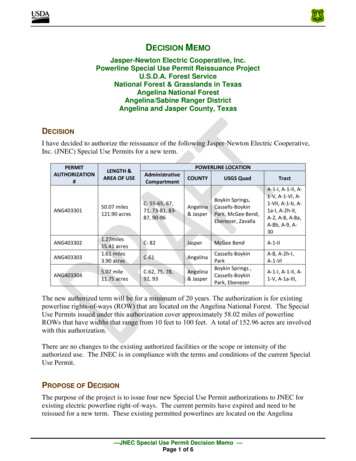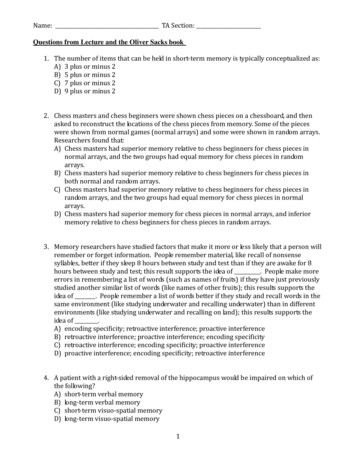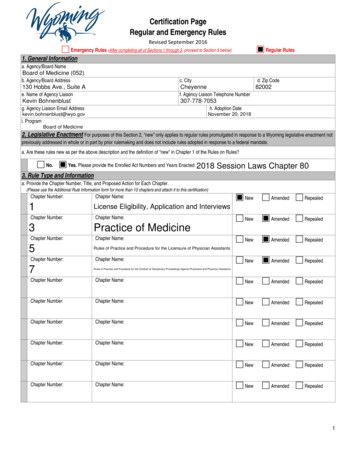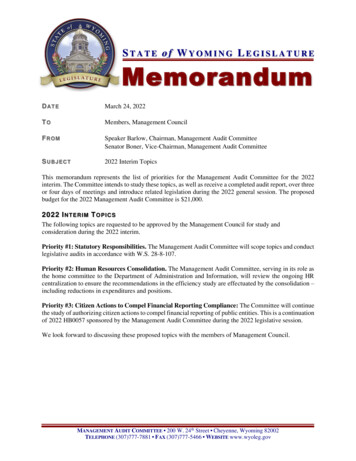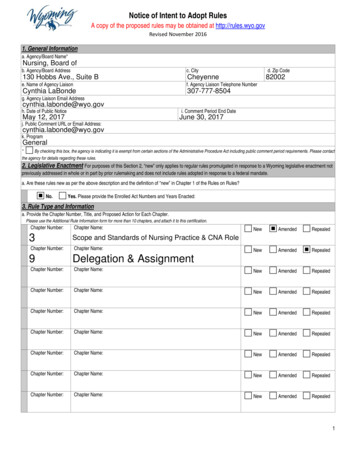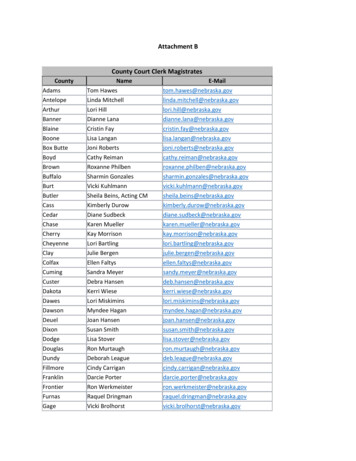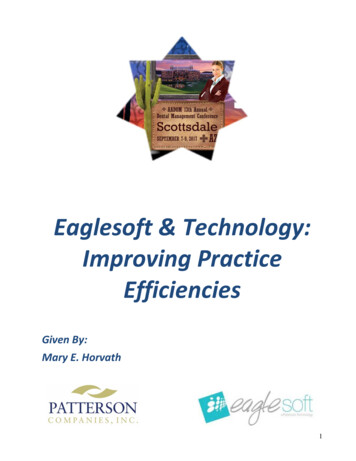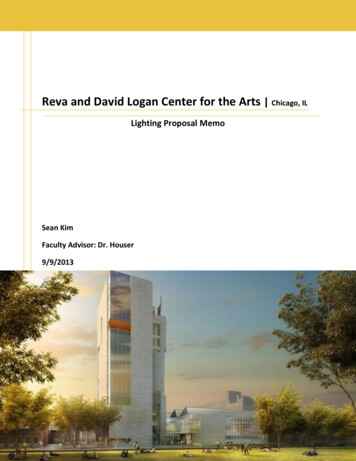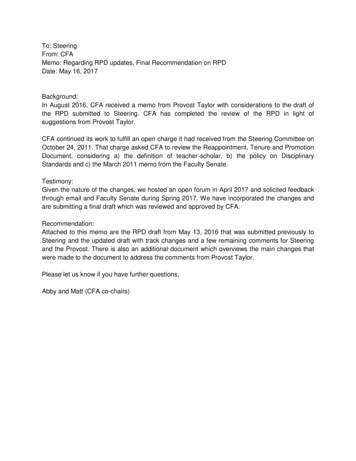
Transcription
9/27/2006Research Memo06 RM 051Date:September 21, 2006Author: Don C. Richards, Senior Research AnalystRe:History of and Financial Background for the Wyoming Community DevelopmentAuthority (WCDA)QUESTIONS1. Provide a very brief overview of the statutory history of the Wyoming Community DevelopmentAuthority (WCDA), including year of initiation, the magnitude (and payback) of any initialappropriation, and current purpose of bond proceeds generated by the WCDA.2. Identify the statutory bonding capacity and quantify the available bonding capacity of WCDA (or,more generally, tax-exempt private activity bonds allocated for Wyoming). Clarify differencesbetween federally tax-exempt governmental bonds, tax-exempt private activity bonds, and taxablebonds issued by WCDA under its state statutory authority.3. Summarize other operating funds, federal funds, or other funds of the WCDA, which the Authoritytraditionally accesses in order to purchase mortgage loans or apply toward other identified programs.ANSWERS1. Authorizing legislation for the WCDA was adopted in 1975 ('75 Laws, Ch. 188). In two separatebills ('75 Laws, Ch. 202, Sec. 10 and '77 Laws, Ch. 32, Sec. 1) the Legislature appropriated a total of 400,000 in the form of no interest loans to be paid back to the General Fund on or before January 1,1982. According to WCDA staff, the full amounts were paid within the timeline specified.1 WCDA'scurrent authorizing legislation provides a comprehensive list of powers and duties. Federalrestrictions and bond restrictions further inform and limit the purposes for which bond proceeds maybe used. That said, a primary power of the WCDA appears in W.S. 9-7-105(a)(xxii) which allows theWCDA to "Make loans, including loans to mortgage lenders to enable the lenders to make loans, tofinance projects, including construction loans and advances, under terms and conditions, and withsecurity therefore, as the authority deems appropriate. The authority shall not make any loan, otherthan loans to mortgage lenders, which is a first lien loan to a homeowner with respect to single familyresidential property."DISCUSSIONAlthough the authorizing legislation for the WCDA included no appropriation, the law states, "Anyappropriation of money to the authority by the 43rd Legislature of the state of Wyoming shall be reimbursed1As of this writing LSO staff have not confirmed those payments, have no reason to suspect the payments were notmade, and, if necessary and with appropriate time, could further research state documentation of the receipts. In theinterest of timely response to this request, LSO has assumed the payments were made by WCDA as required by law.Bolstering this conclusion, the State Treasurer's Office currently reports no outstanding loans to the WCDA.WYOMING LEGISLATIVE SERVICE OFFICE 213 State Capitol Cheyenne, Wyoming 82002TELEPHONE (307) 777-7881 FAX (307) 777-5466 EMAIL lso@state.wy.us WEBSITE http://legisweb.state.wy.us
PAGE 2 OF 5and repaid by the authority to the general fund of the state treasury on or before January 1, 1982."Furthermore, the General Appropriations (Budget Bill) adopted by the Legislature in 1975 provided, "Thereis hereby appropriated to the Wyoming community development authority from the general fund of the statetreasury, the sum of three hundred thousand dollars ( 300,000.00), or so much thereof as may be necessaryto pay the costs of administration of the authority. The monies herein appropriated shall be reimbursed andrepaid to the general fund of the state treasury, in full principal amount without interest, not later thanJanuary 1, 1982." Subsequently, the Legislature provided an additional 100,000 from the general fund, freeof interest, to WCDA in 1977 in the form of a loan. This subsequent, additional loan included the samerepayment deadline as the original 300,000 loan.In terms of the purposes for which bond proceeds may be used, W.S. 9-7-105 and W.S. 9-7-106 articulate thepowers and limitations of the WCDA. Briefly, and in addition to the purchase of mortgage loans, WCDA isauthorized to prepare plans, specifications, designs and cost estimates for the construction, reconstruction,rehabilitation, improvement, alteration or repair of any project or economic development project, modify theplans, specifications, designs or estimates; and manage any project or economic development project,whether owned or leased by the authority.22. The state statutory limitations on bonding for the WCDA are currently articulated under W.S. 9-7108 (h) and (j). These state bonding limitations amount to 650 million for specified purposes.However, due to the broad exclusions from the state statutory language combined with the standardoperation of the WCDA, the 650 million limitation does not provide a meaningful threshold. Inpractice, the (annual and carryover) limitation on federally tax-exempt private activity bonds imposedby the federal government appears to be the controlling authority for the vast majority of WCDAissued bonds.DISCUSSIONState statute limitation on WCDA's bonding capacity are provided in W.S. 9-7-108(h) and (j), which state:(h) In addition to the bonds presently outstanding, any bonds authorized for care facility projects,bonds that may be issued to refund bonds, and bonds the authority may issue from time to time asprivate activity bonds exempt from federal income taxation under section 146 of the internalrevenue code of 1986, as amended, the authority may issue and have outstanding additional bondsin an aggregate amount of up to four hundred million dollars ( 400,000,000.00).2"Economic development" is defined in W.S. 9-7-103(a)(iv) as "any land, building or other improvement and all realand personal property including machinery and equipment suitable for:(A) Manufacturing, processing or assembling agricultural or manufactured products;(B) Storing, warehousing, distributing or selling agricultural, mining or industrial products or any related processesincluding research and development;(C) Health care including any facility used or occupied by any person for providing services in any home for theelderly, any nursing home, rest home or facility providing living space for the developmentally disabled or any personsixty (60) years of age or older;(D) Airports, parking facilities or storage or training facilities directly related to any other facility specified under thisparagraph;(E) Industrial park facilities;(F) Sewage or solid waste disposal facilities;(G) Facilities furnishing electric energy, gas or water;(H) Any other project which can be financed by a municipality or county pursuant to the definition of project underW.S. 15-1-701(a)(ii);(J) Secondary, tertiary and enhanced mineral recovery projects."WYOMING LEGISLATIVE SERVICE OFFICE 213 State Capitol Cheyenne, Wyoming 82002TELEPHONE (307) 777-7881 FAX (307) 777-5466 EMAIL lso@state.wy.us WEBSITE http://legisweb.state.wy.us
PAGE 3 OF 5(j) In addition to the bonds authorized by subsection (h) of this section, the authority may issueand have outstanding additional bonds for care facility projects in an aggregate amount of up totwo hundred fifty million dollars ( 250,000,000.00). (emphasis added)3As of June 30, 20054, the audited financial statements of WCDA indicate that the Authority hasapproximately 763 million in outstanding bonds payable. According to WCDA "nearly all" of theoutstanding bonds are characterized as tax-exempt private activity bonds and, therefore, not subject to thespecific thresholds provided in W.S. 9-7-108(h). Among the limited amount of outstanding bonds notsubject to the tax-exempt private activity limitation are 1,702,744 of 1992 Wyoming HomeownershipRevenue Bonds. The same figure is noted in the State Treasurer's annual report, indicating that the state isthe sole purchaser of all of the outstanding bonds from the outstanding series. In sum, only a couple milliondollars of bonds could be readily identified that are subject to the 650 million cap imposed in state statute.5Consequently, WCDA retains nearly all of its 650 million in state provided bonding capacity. Thefundamental difference between the federally tax-exempt private activity bonding authority and the revenuebonding authority specifically authorized and limited by state statute (W.S. 9-7-108(h) and (j)) is the formeris tax exempt (therefore, "subsidized" with below market interest payable) and the latter is not. However,since the bondholder in the current example is the State, which is not subject to federal income tax, no tax ispayable.State and local governments are allowed to issue tax exempt bonds, "governmental bonds" the proceeds ofwhich "are generally used to finance activities or facilities owned, operated, or used by that or anothergovernment for its own purposes."6 Government bonds issued by the state or its political subdivisions andused exclusively for government purposes are also tax-exempt, and to the extent the volumes and bondratings are similar, could be expected to benefit from roughly the same "subsidy" since they should carrybelow market rates as compared to taxable bonds.In contrast, tax-exempt private activity bonds are also issued by a state or local government, but "theproceeds of which are used for a defined qualified purpose by an entity other than the government issuingthe bonds."7 (emphasis added) To qualify for tax-exempt status, private activity bonds must meet an array offederal requirements as well as fall within the annual volume limitation established for each state by thefederal government subject to the provisions of 26 U.S.C. 146. As a gross generalization, to qualify as aprivate activity bond, the issue must meet a combination of several tests – either (1) the private business usetest and the private security or payment test or (2) the private loan financing test.8 As indicated previously,3LSO Legal staff should be consulted regarding other state Constitutional debt limitations and the authority of theWCDA to issue certain types of revenue bonds, which appear to be beyond the scope of this memo and the expertise ofLSO Research staff.4The FY06 final, audited financial statements of WCDA are not expected to be completed and released for anotherweek or so after the date of this writing. Consequently, FY05 statements have been used. According to WCDA staffthe outstanding revenue bonds owned by the State Treasurer have declined to roughly 1.4 million outstanding. Thatsaid, within the context of the response, these minor differences pose little substantial difference.5In order to meet the deadline restrictions of this memo, LSO staff have made some broad generalizations in itsresearch. LSO did not verify that each of the dozens of bond series outstanding to confirm all series met the privateactivity limitations annually imposed by the federal government. LSO accepted that claim of WCDA staff, in general,and limited discussion only to specific bond series.6IRS Publication 4079, Tax-Exempt Governmental Bonds, p. 2.7IRS Publication 4078, Tax-Exempt Private Activity Bonds, p.2.8See 26 USC 141(a). As defined by the IRS, the business use test requires more than 10 percent of the proceeds of anissue will be used for any private business use. The private payment or security test requires more than 10 percent ofWYOMING LEGISLATIVE SERVICE OFFICE 213 State Capitol Cheyenne, Wyoming 82002TELEPHONE (307) 777-7881 FAX (307) 777-5466 EMAIL lso@state.wy.us WEBSITE http://legisweb.state.wy.us
PAGE 4 OF 5bondholders of qualified private activity bonds are exempt from federal income tax. Therefore, in Wyomingthe WCDA can issue these type of bonds and receive reduced financing costs in the form of lower interestrates since the bonds are exempt from federal income tax. In sum, this benefit indirectly provides a type offederal financing subsidy for eligible projects.W.S. 9-2-219(a) requires the Governor to establish rules and regulations to provide for the allocation of taxexempt private activity bonds subject to the volume limitations established by the federal government.Current rules promulgated by the Governor's Office provide for the allocation of the annual allotment. Therules provides for an established allocation of 90 million for the WCDA, 30 million for the WyomingStudent Loan Corporation (WSLC), and the balance dedicated to a general allocation pool. A prominentexample of the use of the general allocation pool is the Two Elks power generation facility being constructedin Campbell County. Importantly, rules provide that "the remaining balance of the General AllocationPool shall be allocated to the WCDA and carried forward as a carryforward allocation."9 Underfederal law, unused tax-exempt private activity volumes authorized by the federal government to each statecan be carried forward for three years.Records from the Attorney General's Office indicate that the 2006 allocation for tax-exempt private activitybonds for the State amounted to 246,610,000. The Attorney General's office indicates that 19,110,000remains unallocated for this year (2006). According to the Attorney General's records and summing theavailable carryforward from previous years, the available tax-exempt private activity bonding allocationappears to be just under 104 million.103. According to the WCDA's 2005 financial statements, the Authority administers four additionalFunds, aside from Funds containing bond proceeds. They include the Federal Program Fund, theMortgage Guaranty Fund, the General Fund, and the Housing Trust Fund.The Federal Program Fund is supported by Federal HUD resources (and matched resources). Examples ofprograms administered under this fund include the HOME investment partnership program, which assists inrental housing production and homeowner rehabilitation for low-income populations, and the housing portionof federal Community Development Block Grant (CDBG) funds. The Mortgage Guaranty Fund was used tosupport economic development efforts previously found in W.S. 9-7-122 and 9-7-124, which are no longeractive. The General Fund is used for operations and administrative activities of the WCDA board and staff.The Housing Trust Fund is a fund created by the WCDA Board to provide funding for "non-traditionalaffordable housing outside of its tax-exempt bond program." At the end of 2005, the Fund includedinvestments in the form of mortgages of 19.5 million and 5.3 million in available cash. The originalsource of this capital was not bond proceeds but, according to WCDA staff, was revenue from WCDAoperations generated some time ago. In other words, for purposes of description, the "seed capital" wasessentially historical "profits" from WCDA operations. This fund currently is operated by the WCDA as athe payment of principal or interest on the bond issue is either made or secured by payments or property used or to beused for a private business use. The private loan financing test requires the amount of the proceeds of the issue which isto be used to make or finance loans to persons other than governmental entities exceeds the lesser of five percent ofsuch proceeds or 5 million. Private activity bonds require adherence with a series of federal requirements andlimitations. See 26 U.S.C. Subpart A for a complete articulation of the requirements.9There is also a provision in rules which allows entities applying for carryforward bonding authority from the generalallocation pool to receive a substitute allocation from WCDA's defined 90 million pool, essentially as a "swap" fromthe carryforward allocation.10The author of this memo is relying on records and computations provided by the Attorney General's Office for thesefigures. It appears to the author that the records that were provided may be incomplete and potentially misinterpreted.WYOMING LEGISLATIVE SERVICE OFFICE 213 State Capitol Cheyenne, Wyoming 82002TELEPHONE (307) 777-7881 FAX (307) 777-5466 EMAIL lso@state.wy.us WEBSITE http://legisweb.state.wy.us
PAGE 5 OF 5revolving loan fund and no additional capital is currently being added by WCDA. Examples ofnonconforming mortgages financed through this Fund include the purchase of loans that don't fit thequalifications of the tax exempt loans, such as second mortgages of up to 7,500 and multi-family housingprojects such as group homes which serve social programs such as persons with developmental disabilities.If you need anything further, please contact LSO Research at 777-7881.WYOMING LEGISLATIVE SERVICE OFFICE 213 State Capitol Cheyenne, Wyoming 82002TELEPHONE (307) 777-7881 FAX (307) 777-5466 EMAIL lso@state.wy.us WEBSITE http://legisweb.state.wy.us
bonds issued by WCDA under its state statutory authority. 3. Summarize other operating funds, federal funds, or other funds of the WCDA, which the Authority traditionally accesses in order to purchase mortgage loans or apply toward other identified programs. ANSWERS 1. Authorizing legislation for the WCDA was adopted in 1975 ('75 Laws, Ch. 188).
